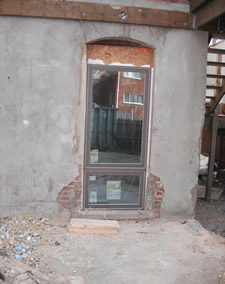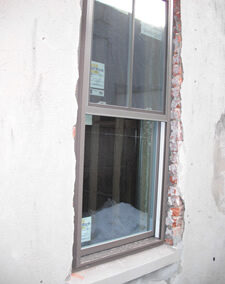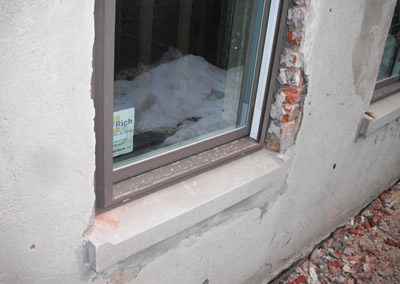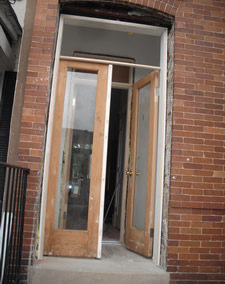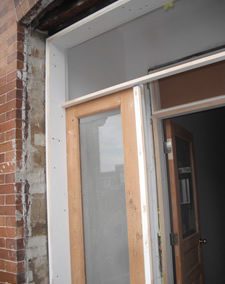Theexisting windows and exterior doors at 753 were all in rough shape andin desperate need of attention. The windows were all single-paneglass, and of the weight and pulley variety. (A lead counter weightconcealed in the window cavity is attached to the window sash with arope that runs over a pulley at the top of the window frame.) Manywindow panes were smashed or missing and all of the wooden windowframes were rotting. Similarly, the exterior doors and door frameswere in various states of decay and disrepair. Therefore, it wasdecided early on in the design process that replacement windows anddoors would be installed as opposed to salvaging the existing.
Had theremodeling project been located in one of the many historicneighborhoods of the city, our replacement windows and doors would havehad to closely match the old. This would have required approval duringthe permitting phase from the historic department in the DCRA. (See Permitting for more information on the permitting process.) We did opt to salvagethe original front doors (at the entrance for both floors) in theinterest of somewhat preserving the original façade, however singlepane glass was replaced with insulated double panes in the interest ofincreasing energy efficiency.
Since753 is not in a historic neighborhood our designer had considerableflexibility when selecting the size, style and material for both thewindows and doors. After some deliberation, we settled on vinylreplacement windows and new wooden doors. In addition to thedurability factor (vinyl never rots or rusts), vinyl windows generallyhave better energy efficiency ratings than those made from wood ormetal. Additionally, the new windows and doors have double panes inwhich argon gas is sealed. This not only reduces the transfer of heatbetween inside/outside, but limits the transmission of sound as well.(See Soundproofing for more information on soundproofing.)
Over a five-day period, our team replaced the windows and exterior doors onboth floors (five doors and 18 windows) by way of the following:
1. Removing and disposing of old windows and doors. Old window weights were salvaged and used on another project.
2. Reworking brick openings to accommodate replacement windows and doors.
- For the most part, window and door openings remained approximately the same size so the majority of this work involved strengthening and re-pointing the masonry around the window openings. (See Exterior Brick Work for detailed information on re-pointing masonry.)
- Openings were re-worked significantly in the first floor kitchen (a window was converted into a door), first floor master bath, second floor kitchen, first floor master suite, and second floor guest bathroom (windows were enlarged to allow for more natural light).
3. Installing new treated framing lumber in reworked openings.
4. Installing pre-cast stone window sills.
5. Setting new windows and doors in openings and fastening them to framing lumber.
6. Spraying high-density insulation in gaps between framing and masonry.

